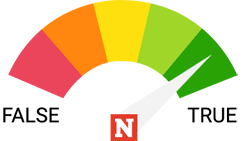The Cassini mission, jointly operated by NASA and the European Space Agency, came to end in 2017 after the spacecraft deliberately plunged into Saturn with its fuel supplies rapidly diminishing.
Cassini spent 20 years in space—13 of those exploring the Saturn system— during which it revolutionized our understanding of the planet and its moons.
But did the spacecraft image a hexagonal region on the northern pole of Saturn, the second-largest planet in the solar system?

The Claim
A post on Reddit has recently gone viral showing a time-lapse video created, it claimed, using data captured by Cassini that shows the majestic "hexagon" located at Saturn's north pole.
The post, which was published on Sunday, has been upvoted more than 18,000 times at the time of writing, with the video sparking curiosity and awe among many Reddit users.
"One of the most beautiful and bizarre sights we have discovered in our solar system," one users commented.
The Facts
Saturn's hexagon is a persistent cloud at the north pole of the planet with an approximately hexagonal shape. The feature, whose sides are roughly 9,000 miles long, is essentially a swirling system of air currents and turbulent weather, which has lasted for decades—perhaps even centuries—and shows no sign of abating.
This mysterious feature was first imaged by the Voyager spacecraft in 1981, but it took several years for the discovery to come to light because it required the stitching together of multiple images to make a complete map of Saturn's north pole.
The hexagon was subsequently viewed by the Hubble Space Telescope, observed from the ground and was also imaged in great detail by Cassini.
The time-lapse featured in the Reddit post was created using several images of Saturn captured over a period of 10 hours by the Cassini spacecraft on December 10, 2012, according to NASA.
In that year, the spacecraft passed over Saturn's poles, providing it with an opportunity to image the hexagon. Each of the eight frames of the time-lapse were produced by combing 16 images—so the the whole video combines data from 128 images in total.
The time-lapse was the highest-resolution view of the hexagon and the first to show it with color filters. The colors in the clip have have been added in post-processing based on the different wavelengths of light being emitted. To human eyes, the hexagon would feature tones of gold and blue.
Several hypotheses have been put forward by scientists to explain Saturn's unique hexagonal feature.
"We think that it's a naturally-forming wave pattern, like the meandering of the jet streams that we see here on Earth, but it takes on this 'perfect' six-sided shape because there's no topography—mountains, valleys, coastlines—to get in the way of the pure fluid flows," Leigh Fletcher, a professor of planetary science from University of Leicester, U.K. who has published research on Saturn, previously told Newsweek.
"The whole Earth would fit along one side of the hexagon, to give you an idea of its size.
The Ruling

True.
While the Cassini spacecraft did not discover Saturn's hexagon, it did image it in 2012, providing the data used to create the time-lapse that has recently gone viral in a Reddit post.
FACT CHECK BY NEWSWEEK
Uncommon Knowledge
Newsweek is committed to challenging conventional wisdom and finding connections in the search for common ground.
Newsweek is committed to challenging conventional wisdom and finding connections in the search for common ground.
About the writer
Aristos is a Newsweek science reporter with the London, U.K., bureau. He reports on science and health topics, including; animal, ... Read more
To read how Newsweek uses AI as a newsroom tool, Click here.





